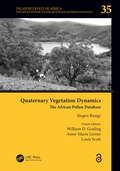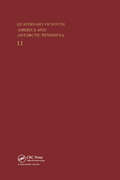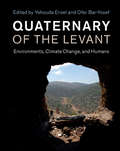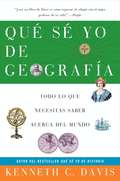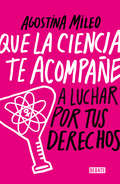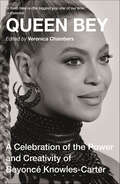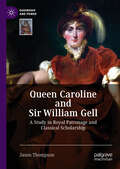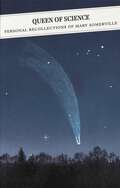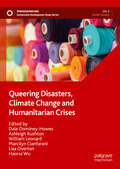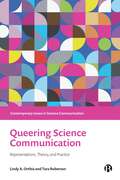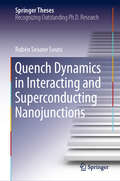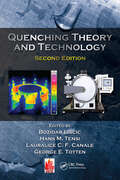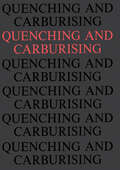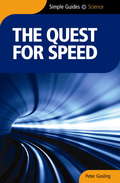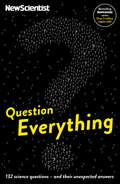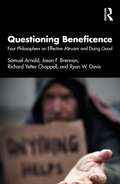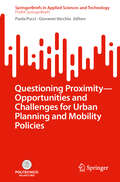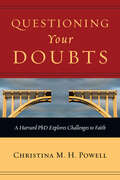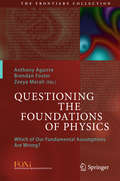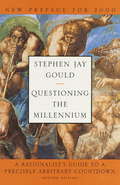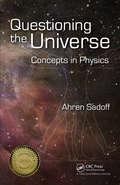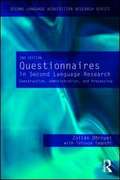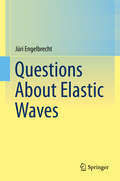- Table View
- List View
Quaternary Vegetation Dynamics: The African Pollen Database (Palaeoecology of Africa #35)
by Jürgen RungeThis book celebrates the relaunch of the African Pollen Database, presents state-of-the-art of modern and ancient pollen data from sub-Saharan Africa, and promotes Open Access science. Pollen grains are powerful tools for the study of past vegetation dynamics because they preserve well within sedimentary deposits and have a huge diversity in ornamentation that allows different taxa to be determined. The reconstruction of past vegetation from the examination of ancient pollen records thus can be used to characterize the nature of past landscapes (e.g. abundance of forests vs. grasslands), provide insights into changes in biodiversity, and gain empirical evidence of vegetation response to climatic change and human activity. In this, the 35th Volume of "Palaeoecology of Africa", we bring together new data and extensive synthetic reviews to provide novel insights into the relationships between human evolution, human activity, climate change and vegetation dynamics during the Quaternary, the last 2.6 million years. Current and ongoing climate and land-use change is exerting pressure on modern vegetation formations and threatening the livelihoods and wellbeing of many peoples in Africa. In this book the focus is on the Quaternary because it is during this geological period that the modern vegetation formations developed into their current configurations against a backdrop of high magnitude global climate change (glacial-interglacial cycles), human evolution, and a growing human land-use footprint. In this book the latest information is presented and collated from around the African continent to parameterize past vegetation states, identify the drivers of vegetation change, and assess the vegetation resilience to change. To achieve this research from two broad themes are covered: (i) the present is the key to the past (i.e. studies which improve our understanding of modern environments so that we can better interpret evidence from the past), and (ii) the past is the key to the future (i.e. studies which unlock information on how and why vegetation changed in the past so one can better anticipate trajectories of future change). This Open Access book will provide a strong foundation for future research exploring past ecological, environmental and climatic change within Africa and the surrounding islands. The book is organized regionally (covering western, eastern, central, and southern Africa) and it contains specialized articles focused on particular topics (such as modern pollen-vegetation relationships and fire as a driver of vegetation change), as well as regional and pan-African syntheses drawing together decades of research to assess key scientific questions (including the role of climate in driving vegetation change and the role of vegetation change in human evolution). These articles will be useful to students and teachers from high school to the highest level of university who are interested in the origins and dynamics of vegetation in Africa. Furthermore, it is also meant to provide societally relevant information that can act as an inspiration for the development of sustainable management practices for the future.
Quaternary of South America and Antarctica Peninsula 1998
by JORGE RABASSA; MÓNICA SALEMMEThis text deals with certain geological aspects of the extreme geographical locations of South America and the Antarctic Peninsula. Topics include: Brazil - geology and vertebrate paleontology; pleistocene wave-built terraces of Northern Rio de Janeiro state; and holocene coastal evolution.
Quaternary of the Levant: Environments, Climate Change, and Humans
by Yehouda Enzel Bar-Yosef OferQuaternary of the Levant presents up-to-date research achievements from a region that displays unique interactions between the climate, the environment and human evolution. Focusing on southeast Turkey, Lebanon, Syria, Jordan and Israel, it brings together over eighty contributions from leading researchers to review 2. 5 million years of environmental change and human cultural evolution. Information from prehistoric sites and palaeoanthropological studies contributing to our understanding of 'out of Africa' migrations, Neanderthals, cultures of modern humans, and the origins of agriculture are assessed within the context of glacial-interglacial cycles, marine isotope cycles, plate tectonics, geochronology, geomorphology, palaeoecology and genetics. Complemented by overview summaries that draw together the findings of each chapter, the resulting coverage is wide-ranging and cohesive. The cross-disciplinary nature of the volume makes it an invaluable resource for academics and advanced students of Quaternary science and human prehistory, as well as being an important reference for archaeologists working in the region.
Que Se Yo de Geografia
by Kenneth C. DavisAcompáñanos mientras Kenneth C. Davis, autor del bestseller Qué Sé Yo de Historia, nos lleva en un fascinante, asombroso y divertidísimo tour del planeta Tierra -- una excursión que nos abrirá los ojos y la imaginación a un extenso, salvaje y sorprendente mundo que no conocíamos.
Que la ciencia te acompañe: A luchar por tus derechos
by Agostina MileoDatos científicos de los temas clave en la agenda de género para sostener la crítica feminista. Aunque la humanidad no está formada solo por varones blancos heterosexuales, ellos son el modelo con que el mundo todo se organiza y se piensa. El sexo, la economía, la salud, la tecnología, incluso la ciencia -amparada por una supuesta neutralidad y objetividad-, refuerza estereotipos patriarcales que pasan desapercibidos la mayoría de las veces. Por suerte, Agostina Mileo confronta con sensatez los prejuicios y desarma con lenguaje claro e información accesible, cada uno de los lugares comunes en los que se arraiga el machismo, abriendo la discusión sobre temas como la "utilidad" de los orgasmos, las diferencias entre el cerebro "femenino" o "masculino" (¿y trans?), las falacias sobre el aborto y los mitos de la menstruación. Con irreverencia, demuestra por qué es imperioso construir una mirada crítica y diversa sobre la producción y comunicación del conocimiento, y cuestionar nuestras propias opiniones una y otra vez. En la lucha por una sociedad igualitaria, necesitamos que también ¡la ciencia nos acompañe!
Queen Bey: A Celebration of the Power and Creativity of Beyoncé Knowles-Carter
by Veronica ChambersFEATURED IN: The New York Times Book Review ("New and Noteworthy") •Essence • Newsweek•People • Bustle • PopSugar • Refinery 29 • HelloGiggles' • PureWow • Newsday• AMNewYorkThe Ultimate Beyoncé Collectible"Beyoncé fans will eat it up." —People"You don't need to be in the Beyhive to appreciate Queen Bey...Voices including culture critic Luvvie Ajayi and actress and producer Lena Waithe give us a fresh take on Beyoncé, who's arguably the biggest pop star of our time." —EssenceBeyoncé. Her name conjures more than music, it has come to be synonymous with beauty, glamour, power, creativity, love, and romance. Her performances are legendary, her album releases events. She is not even forty but she has already rewritten the Beyoncé playbook more than half a dozen times. She is consistently provocative, political and surprising. As a solo artist, she has sold more than 100 million records. She has won 22 Grammys and is the most-nominated woman artist in the history of Grammy awards. Her 2018 performance at Coachella wowed the world. The New York Times wrote: "There's not likely to be a more meaningful, absorbing, forceful and radical performance by an American musician this year or any year soon." Artist, business woman, mother, daughter, sister, wife, black feminist, Queen Bey is endlessly fascinating. Queen Bey features a diverse range of voices, from star academics to outspoken cultural critics to Hollywood and music stars. Essays include:"What Might a Black Girl Be in This World," an introduction by Veronica Chambers"Beychella is Proof That Beyoncé is the Greatest Performer Alive. I’m Not Arguing." by Luvvie Ajayi"On the Journey Together," by Lena Waithe"What Beyoncé Means to Everyone," by Meredith Broussard with visualizations by Andrew Harvard and Juan Carlos Mora"Jay-Z's Apology to Beyoncé Isn't Just Celebrity Gossip — It's a Political Act" by Brittney Cooper"All Her Single Ladies" by Kid Fury "The Elevator" by Ylonda Gault "The Art of Being Beyoncé" by Maria Brito"Getting, Giving and Leaving" by Melissa Harris Perry and Mankaprr Conteh"Beyoncé the Brave" by Reshma Saujani"Living into the Lemonade: Redefining Black Women’s Spirituality in the Age of Beyoncé" by Candice Benbow"Beyoncé’s Radical Ways" by Carmen Perez"Finding la Reina in Queen Bey" by Isabel Gonzalez Whitaker"Beyoncé, Influencer" by Elodie Maillet Storm"The King of Pop and the Queen of Everything" by Michael Eric Dyson"Style So Sacred" by Edward Enninful"The Beauty of Beyoncé" by Fatima Robinson "Because Beyoncé." by Ebro Darden"King Bey" by Treva B. Lindsey"Meridonial: Beyoncé’s Southern Roots and References" by Robin M. Boylorn"B & V: A Love Letter" by Caroline Clarke
Queen Caroline and Sir William Gell: A Study in Royal Patronage and Classical Scholarship (Queenship and Power)
by Jason ThompsonThis book explores the relationship between Queen Caroline, one of the most enigmatic characters in Regency England, and Sir William Gell, the leading classical scholar of his day. Despised and rejected by her husband, Caroline created a sphere and court of her own through patronage of scholarship. The primary beneficiary was Gell, a pioneering scholar of the classical world who opened new dimensions in the study of ancient Troy, mainland Greece, and Ithaca. Despite his achievements, Gell had scarce financial resources. Support from Caroline enabled him to establish himself in Italy and conduct his seminal work about ancient Rome and, especially, Pompeii, until her sensational trial before the House of Lords and premature death. Concluding with the first scholarly transcription of the extraordinary series of letters that Caroline wrote to Gell, this volume illuminates how Caroline sought power through patronage, and how Gell shaped classical scholarship in nineteenth-century Britain.
Queen of Science: Personal Recollections of Mary Somerville (Canongate Classics #102)
by Mary SomervilleThe complete memoirs of the 19th century scientist, public intellectual, and first female member of the Royal Astronomical Society.Born in Jedburgh in 1780, Mary Fairfax was the daughter of a captain in Lord Nelson&’s navy. In common with most girls of her time and station, she received an education that prized gentility over ability. Nevertheless, she taught herself algebra in secret, and made her reputation in celestial mechanics with her 1831 translation of Laplace&’s Mécanique céleste as The Mechanism of the Heavens.A brilliant polymath with interests in art, literature and nature, Somerville&’s memoirs give a fascinating picture of her life and times from childhood in Burntisland to international recognition and retirement in Naples. She recounts memories of comets and eclipses, high society in London and Paris, Charles Babbage and his calculating engine, encounters with Sir Walter Scott and Fenimore Cooper, the Risorgimento in Italy and the eruption of Vesuvius.Selected by her daughter and first published in 1973, these are the memoirs of a remarkable woman who became one of the nineteenth century&’s most accomplished mathematicians and scientists. Oxford&’s Somerville College was named after her, and the present volume, re-edited by Dorothy McMillan, draws on manuscripts owned by the college, offering the first unexpurgated edition of these revelatory writings.
Queer Ducks (and Other Animals): The Natural World of Animal Sexuality
by Eliot SchreferThis groundbreaking illustrated YA nonfiction title from two-time National Book Award finalist and New York Times bestselling author Eliot Schrefer is a well-researched and teen-friendly exploration of the gamut of queer behaviors observed in animals.A quiet revolution has been underway in recent years, with study after study revealing substantial same-sex sexual behavior in animals. Join celebrated author Eliot Schrefer on an exploration of queer behavior in the animal world—from albatrosses to bonobos to clownfish to doodlebugs.In sharp and witty prose—aided by humorous comics from artist Jules Zuckerberg—Schrefer uses science, history, anthropology, and sociology to illustrate the diversity of sexual behavior in the animal world. Interviews with researchers in the field offer additional insights for readers and aspiring scientists.Queer behavior in animals is as diverse and complex—and as natural—as it is in our own species. It doesn’t set us apart from animals—it bonds us even closer to our animal selves.
Queering Disasters, Climate Change and Humanitarian Crises (Sustainable Development Goals Series)
by Dale Dominey-Howes Ashleigh Rushton William Leonard Marcilyn Cianfarani Lisa Overton Haorui WuThis book marks a significant contribution to the development of queer disaster studies - exploring how disaster-related experiences and needs of sexual and gender diverse (LGBTIQA+) people manifest and differ across national, cultural, and regional boundaries from the Global North and South; from culturally diverse communities, drawing together researchers and professionals working in government, non-government agencies, emergency management, community, and humanitarian organisations. Uniquely, it contains contributions from sexual and gender diverse people with lived experience of disasters, climate change and humanitarian crises and people who have been subject to heterosexist discrimination in disaster relief and recovery-related services, as employees and volunteers.A crucial, overdue contribution to achieving the United Nations Sustainable Development Goals 5: Gender Equality, this book identifies areas to further the development of just and equitable disaster, climate change and humanitarian crises policy, programs, and services that include and address the needs of sexual and gender diverse people.
Queering Science Communication: Representations, Theory, and Practice
by Lindy A. Orthia and Tara RobersonA book on queer themes and science communication is timely, if not well overdue. LGBTIQA+ people have unique contributions to make and issues to meet through science communication. So, bringing ‘queer’ and ‘science communication’ together is an important step for queer protest, liberation, and visibility. This collection examines the place of queer people within science communication and asks what it means for the field to ‘queer’ science communication practice, theory and research agendas. Written by leading names in the field, it offers concrete examples for academics, students and practitioners who strive to foster radical inclusivity and equity in science communication.
Queering the Biopolitics of Citizenship in the Age of Obama
by Judy RohrerWhere dominant citizenship narratives have heretofore focused on either the state or the nation as qualifiers of belonging, this book draws from the interdisciplinary fields of queer theory, critical race theory, feminist political theory, disability studies, and indigenous studies to further an evolving discussion of what it means to be an American citizen in the Obama era. Rohrer demonstrates that this discussion requires an understanding of the machinations of governmentality and biopolitics in the (re)production of the (proper) citizen.
Quench Dynamics in Interacting and Superconducting Nanojunctions (Springer Theses)
by Rubén Seoane SoutoEffects of many-body interactions and superconducting correlations have become central questions in the quantum transport community. While most previous works investigating current fluctuations in nanodevices have been restricted to the stationary regime, Seoane's thesis extends these studies to the time domain. It provides relevant information about the time onset of electronic correlations mediated by interactions and superconductivity. This knowledge is essential for the development of fast electronic devices, as well as novel applications requiring fast manipulations, such as quantum information processing. In addition, the thesis establishes contact with issues of broad current interest such as non-equilibrium quantum phase transitions.
Quenching Theory and Technology
by George E. Totten Hans M. Tensi Božidar Liščić Lauralice C. F. CanaleQuenching is one of the most fundamentally complex processes in the heat treatment of metals, and it is something on which mechanical properties and distortion of engineering components depend. With chapters written by the most respected international experts in the field, Quenching Theory and Technology, Second Edition presents the most authoritat
Quenching and Carburising: Proceedings of the 3rd International Seminar of the International Federation for Heat Treatment (Melbourne, 1991)
by Peter D. HodgsonProceedings of the 3rd International Seminar of the International Federation for Heat Treatment held in Melbourne, in 1991 with the special focus on ‘Quenching and Carburising’. Quenching and Carburising are two of the most basic and widely practised steel heat treatment processes. Each allows the base properties and performance of the steel to be significantly enhanced, such that a relatively inexpensive and simple starting material can be used for a wide range of demanding applications. Nevertheless, the technological developments within those two processes are often ignored in favour of ‘high tech’ surface treatments. The aim of Quenching and Carburising was to review the recent advancements that have been made in these fields.
Quest For Speed - Simple Guides
by Peter GoslingMan's quest for speed is driven by two ambitions. One is the competitive urge to excel -- to go as fast as possible by any available means, and preferably to go faster than anybody else. The other, more practical, aim is to make travel and transport as swift and efficient as possible. The two are closely linked, since by pushing technology to the limit to achieve the first, we improve performance in the second, with results that continue to shrink the world.In this book Peter Gosling tells the fascinating story of the key scientific discoveries and technological breakthroughs in our drive to conquer distance -- from our earliest crude efforts using animal power and the wheel, to harnessing the wind and the waves, on through the watershed of the Industrial Revolution, rail and steam, the invention of the internal combustion engine, through powered flight to rocketry, and on to space travel. We look at developments on land, sea, and air, and the novel "green" solutions that scientists are exploring in order to meet today's environmental challenges. Along the way we meet some of the remarkable men and women behind these breakthroughs, whose vision and determination have helped to shape the modern world. Written in an engaging, non-technical style, The Quest for Speed captures both the thrill of the race and the adventure of science, and points to the social and cultural changes ahead as technology accelerates the pace of life and transforms the human landscape.SIMPLE GUIDES: SCIENCESimple Guides: Science are user-friendly introductions to the great scientific discoveries of the world. Written by experts in the field, they offer the general reader simple and engaging descriptions of key developments and breakthroughs in different fields of science and technology. * Simple Guides: Science are written in a clear, informal style, using plain, non-technical language to provide accessible introductions to complex scientific theories.* Organized both by theme and chronologically, the books link the major breakthroughs to the lives of their discoverers and inventors.* The clear structure and design enable the general reader to grasp essentials easily. * These guides will appeal to readers with no specific scientific knowledge, yet with a thirst to know more about the world we live in.* The scientific developments and theories are brought to life by descriptions of their social contexts; not only the breakthroughs are described, but also their impact on society and the human story behind the scientists.
Question Everything: 132 science questions -- and their unexpected answers
by New ScientistAll science begins with questions... - Why is the night sky black, even though it's full of stars? - How do pebbles skim on water? - Why doesn't your own snoring wake you up? - And why is the Large Hadron Collider so ... er ... large? And as these intriguing, imaginative and occasionally bonkers questions and answers drawn from New Scientist magazine's archives show: question everything and you might find your way to amazing, unexpected insights into our minds, bodies and the universe, and the science behind the scenes that keeps them ticking.As you would expect from New Scientist, this is top-flight science at its most accessible, unpredictable and entertaining. This latest mind-bending addition to the No. 1 bestselling series will fascinate 'Last Word' fans and new readers alike.
Questioning Beneficence: Four Philosophers on Effective Altruism and Doing Good
by Jason F. Brennan Richard Yetter Chappell Ryan W. Davis Samuel ArnoldEffective Altruism is a movement and a philosophy that has reinvigorated the debate about the nature of beneficence. At base, it is the consistent application of microeconomic principles to beneficent action. The movement has exposed that many forms of giving do little good (or do active harm), but others do tremendous good.Questioning Beneficence uses Effective Altruism as a launch pad to ask hard questions about beneficence more generally. Must we be Effective Altruists, or are Effective Altruism and the ideas driving the movement a mistake? How much should we give—if anything— and how should we give it? What are the respective roles of different kinds of institutions? Is charity anti-democratic and do billionaire philanthropists have too much power? Is Effective Altruism just utilitarianism in disguise?Questioning Beneficence is written by four philosophers, each with distinct points of view. It introduces a new standard for debating ideas in philosophy as each author poses and answers three questions and each of his three co-authors responds to those questions in turn. Finally, the first author replies to his co-authors’ responses. Throughout the book, there is a spirit of curiosity, intellectual risk taking, and truth-seeking, rather than point-scoring and one-upmanship. This book demonstrates what open-minded, real dialogue on an important issue can be at its very best.Key Features: Introduces a new roundtable format for philosophical debates: each of four authors takes the lead in constructing and answering three questions, each co-author then responds, and the first author then replies to the others’ responses. Explores salient philosophical questions raised by beneficence, like Can philanthropy be undemocratic? Why are people so bad at charity and what can we do about it? How important is beneficence compared to other values? Can Effective Altruism be part of a meaningful moral life? Consistently written in a clear and engaging style, suitable for both undergraduate students and curious general readers
Questioning Proximity - Opportunities and Challenges for Urban Planning and Mobility Policies (SpringerBriefs in Applied Sciences and Technology)
by Paola Pucci Giovanni VecchioThe book discusses some of the issues related to proximity, challenges an acritical use of the concept and highlights several dimensions that may better frame the actual contribution of proximity to urban and mobility planning in different places. The contributions address the conditions required for ensuring accessibility by proximity and the different planning dimensions that can support its promotion, addressing issues related to the inclusiveness of this model, as well as the scalability and metrics of proximity we need to deal with in several different contexts. The first part of the book introduces some experimental approaches aimed at operationalising accessibility by proximity, while the second part discusses several planning issues related to the implementation of proximity at different scales.
Questioning Your Doubts: A Harvard PhD Explores Challenges to Faith
by Christina M. PowellHow can we know if God is real? Does God truly care about us? Why does God create people he knows will reject him? Why did God allow my friend to become a rape victim? Should I switch jobs? Is this person the one I should marry? If you have pondered these doubts, you are not alone. Sometimes we have intellectual questions about the plausibility of God. Other times we go through difficult life experiences that cause us to question our faith. Sometimes we simply struggle feeling confident with day-to-day decisions. Christina Powell knows what it's like to grapple seriously with challenges to faith. A trained scientist and cancer researcher, she struggled with the mysterious claims of a God who exists beyond what the scientific method could detect. Using personal stories from her own life, she explores how faith can be rooted in rationality, knowledge and facts, while coming to recognize the limits of science in evaluating matters of faith. Asking good questions can help us clarify and refine our faith. We can think critically about our doubts and learn to discern the true and the good. Powell probes the hidden factors that fuel our doubts to help us move beyond skepticism, disillusionment or painful life circumstances. We can live deeper into our questions in the context of Christian community. Ultimately we can work through challenges to faith and find a renewed confidence in our beliefs. It's okay to question your faith. But don't stop there. Question your doubts as well.
Questioning the Foundations of Physics
by Anthony Aguirre Brendan Foster Zeeya MeraliThe essays in this book look at way in which the fundaments of physics might need to be changed in order to make progress towards a unified theory. They are based on the prize-winning essays submitted to the FQXi essay competition ?Which of Our Basic Physical Assumptions Are Wrong, which drew over 270 entries. As Nobel Laureate physicist Philip W. Anderson realized, the key to understanding nature's reality is not anything ?magical?, but the right attitude, ?the focus on asking the right questions, the willingness to try (and to discard) unconventional answers, the sensitive ear for phoniness, self-deception, bombast, and conventional but unproven assumptions. 'The authors of the eighteen prize-winning essays have, where necessary, adapted their essays for the present volume so as to (a) incorporate the community feedback generated in the online discussion of the essays, (b) add new material that has come to light since their completion and (c) to ensure accessibility to a broad audience of readers with a basic grounding in physics. The Foundational Questions Institute, FQXi, catalyzes, supports, and disseminates research on questions at the foundations of physics and cosmology, particularly new frontiers and innovative ideas integral to a deep understanding of reality, but unlikely to be supported by conventional funding sources.
Questioning the Millennium: A Rationalist's Guide to a Precisely Arbitrary Countdown
by Stephen Jay GouldIn this new edition of Questioning the Millennium, best-selling author Stephen Jay Gould applies his wit and erudition to one of today's most pressing subjects: the significance of the millennium. In 1950 at age eight, prompted by an issue of Life magazine marking the century's midpoint, Stephen Jay Gould started thinking about the approaching turn of the millennium. In this beautiful inquiry into time and its milestones, he shares his interest and insights with his readers. Refreshingly reasoned and absorbing, the book asks and answers the three major questions that define the approaching calendrical event. First, what exactly is this concept of a millennium and how has its meaning shifted? How did the name for a future thousand-year reign of Jesus Christ on earth get transferred to the passage of a secular period of a thousand years in current human history? When does the new millennium really begin: January 1, 2000, or January 1, 2001? (Although seemingly trivial, the debate over this issue tells an intriguing story about the cultural history of the twentieth century.) And why must our calendars be so complex, leading to our search for arbitrary regularity, including a fascination with millennia? This revised edition begins with a new and extensive preface on a key subject not treated in the original version.As always, Gould brings into his essays a wide range of compelling historical and scientific fact, including a brief history of millennial fevers, calendrical traditions, and idiosyncrasies from around the world; the story of a sixth-century monk whose errors in chronology plague us even today; and the heroism of a young autistic man who has developed the extraordinary ability to calculate dates deep into the past and the future. Ranging over a wide terrain of phenomena--from the arbitrary regularities of human calendars to the unpredictability of nature, from the vagaries of pop culture to the birth of Christ--Stephen Jay Gould holds up the mirror to our millennial passions to reveal our foibles, absurdities, and uniqueness--in other words, our humanity.
Questioning the Universe: Concepts in Physics (Discovering Physics)
by Ahren SadoffWINNER 2009 CHOICE AWARD OUTSTANDING ACADEMIC TITLE! The typical introduction to physics leaves readers with the impression that physics is about 30 different, unconnected topics such as motion, forces, gravity, electricity, light, heat, energy, and atoms. More often than not, these readers are left to conclude that physics is mostly about boring,
Questionnaires in Second Language Research: Construction, Administration, and Processing
by Zoltan Dornyei Tatsuya TaguchiQuestionnaires in Second Language Research: Construction, Administration, and Processing is the first guide in the second language field devoted to the question of how to produce and use questionnaires as reliable and valid research instruments. It offers a thorough overview of the theory of questionnaire design, administration, and processing, made accessible by concrete, real-life second language research applications. This Second Edition features a new chapter on how an actual scientific instrument was developed using the theoretical guidelines in the book, and new sections on translating questionnaires and collecting survey data on the Internet. Researchers and students in second language studies, applied linguistics, and TESOL programs will find this book invaluable, and it can also be used as a textbook for courses in quantitative research methodology and survey research in linguistics, psychology, and education departments.
Questions About Elastic Waves
by Jüri EngelbrechtThis book addresses the modelling of mechanical waves by asking the right questions about them and trying to find suitable answers. The questions follow the analytical sequence from elementary understandings to complicated cases, following a step-by-step path towards increased knowledge. The focus is on waves in elastic solids, although some examples also concern non-conservative cases for the sake of completeness. Special attention is paid to the understanding of the influence of microstructure, nonlinearity and internal variables in continua. With the help of many mathematical models for describing waves, physical phenomena concerning wave dispersion, nonlinear effects, emergence of solitary waves, scales and hierarchies of waves as well as the governing physical parameters are analysed. Also, the energy balance in waves and non-conservative models with energy influx are discussed. Finally, all answers are interwoven into the canvas of complexity.
